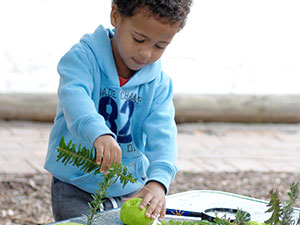More fun with playdough – Child
 While children have, fun making and playing with dough they are also expanding their creativity and understanding of size and space.
While children have, fun making and playing with dough they are also expanding their creativity and understanding of size and space.
Did you know?
Imagination and creativity can flourish as children have multi-sensory experiences. Try using objects with different textures, colours and shapes; like twigs, gumnuts and leaves while playing with playdough.
Add language – for planning, thinking and doing
Involving your child in making the dough gives them practice following instructions. If you have a recipe to follow they learn that instructions can be written down. It is also an opportunity for a conversation and thinking out aloud e.g. “What do you think will happen when we add the hot water?” “The dough is too sticky. What should we do?” “Let’s see what happens if we mix the yellow and the red colours!”
Playdough and other creative play together gives your child time to talk about what they are planning, doing and creating.
Other development
Mixing, kneading and shaping the dough promotes strong muscle development in the fingers, hands and wrists – especially important for pencil and scissor control later on.
Introducing basic tools like a rolling pin, garlic press, scissors and other cutting implements can encourage and extend your child’s interest in playdough. It also helps build those fine motor skills for school.
Safety
Pay special attention to safety when using hot water when making playdough. Home-made playdough is safe to eat although discourage children from consuming large quantities.
Here is a quick easy recipe which keeps well in the fridge for months:
Making Playdough
Ingredients
1 cup salt
2 cups plain flour
2 tablespoons oil
3 teaspoons cream of tartar
2 cups boiling water
colour if required
Method
1. Combine ingredients (except water) in a bowl.
2. Pour the boiling water and stir.
3. Knead lightly on table top.

